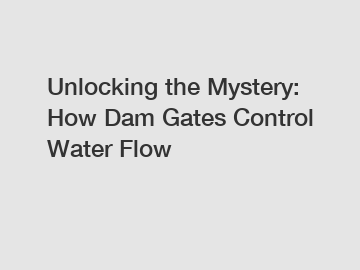Unlocking the Mystery: How Dam Gates Control Water Flow
Have you ever wondered how dams control the flow of water? The answer lies in the intricate system of dam gates that regulate the release of water from the reservoir. These gates are a crucial component of any dam infrastructure, responsible for managing water levels, preventing floods, and generating hydroelectric power. In this blog post, we'll take a closer look at how dam gates work and the important role they play in water management.
Dam gates come in various types, each designed for specific purposes. The most common types of dam gates include spillway gates, radial gates, tainter gates, and drum gates. Spillway gates are used to release excess water to prevent flooding, while radial gates can be raised or lowered to control the flow of water. Tainter gates are hinged at the top and open outward to release water, while drum gates are cylindrical in shape and rotate to control water flow.
The operation of dam gates is a complex process that requires careful coordination and precision. When water levels rise in the reservoir, the gates are opened to release water downstream. This helps to prevent overflow and reduce the risk of flooding in the surrounding area. Conversely, when water levels are low, the gates are closed to conserve water and maintain a steady flow for downstream users.

Dam gates are typically operated using hydraulic systems that allow for precise control of water flow. This technology enables dam operators to adjust the gates as needed to respond to changing water levels and environmental conditions. In some cases, automated systems are used to monitor and control the operation of dam gates, ensuring optimal efficiency and safety.
One of the key benefits of dam gates is their ability to regulate water flow for hydroelectric power generation. By controlling the release of water through turbines, dams can generate electricity that is both clean and renewable. This process harnesses the power of flowing water to produce energy, reducing the reliance on fossil fuels and minimizing the environmental impact of electricity generation.
In addition to power generation, dam gates also play a crucial role in water management and conservation. By controlling the flow of water, dams can store and release water as needed to support agriculture, recreation, and other human activities. This helps to ensure a reliable water supply for communities and protects against droughts and water shortages.
The design and operation of dam gates require a high level of expertise and technical knowledge. Engineers and dam operators must carefully consider factors such as water levels, flow rates, and environmental impacts when managing dam gates. Additionally, regular maintenance and inspection are essential to ensure the safe and efficient operation of these critical infrastructure components.
Despite their importance, dam gates can sometimes face challenges and limitations. Extreme weather events, aging infrastructure, and environmental factors can all impact the performance of dam gates. In such cases, proactive measures must be taken to address issues and maintain the integrity of dam systems.
Overall, dam gates are a vital part of water management and play a crucial role in protecting communities, supporting economic development, and promoting sustainable energy production. The complex mechanisms and technologies behind dam gates demonstrate the ingenuity and innovation of human engineering in harnessing the power of water for the benefit of society.
In conclusion, dam gates are essential for controlling water flow and managing reservoir levels. These engineering marvels enable dams to store and release water as needed, providing valuable benefits such as flood control, power generation, and water conservation. As we continue to unlock the mysteries of dam gates, we can appreciate the important role they play in shaping our water resources and building a sustainable future for generations to come.
For more inflatable dam for Indonesia, simplified elevated dam factory, River Course Rubber Dam supplierinformation, please contact us. We will provide professional answers.
235
0
0

Comments
All Comments (0)